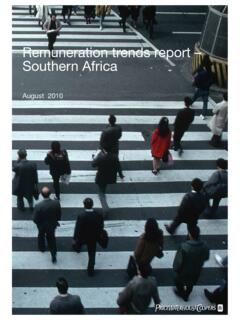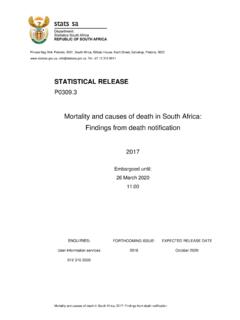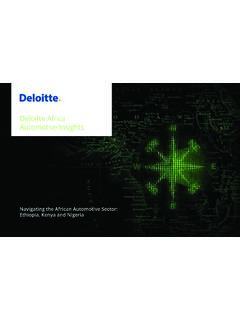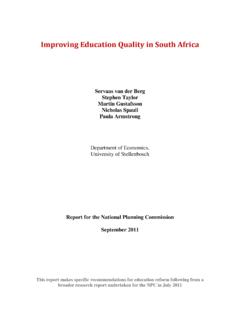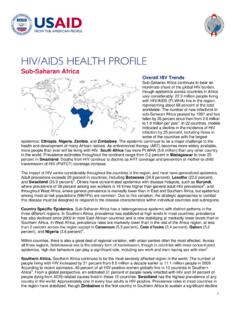Transcription of Report on employment in Africa (Re-Africa)
1 X Report on employment in Africa (Re- Africa ). Tackling the youth employment challenge Report on employment in Africa (Re- Africa ). Tackling the youth employment challenge ILO regional office for Africa Copyright International Labour Organization 2020. First published 2020. Publications of the International Labour Office enjoy copyright under Protocol 2 of the Universal Copyright Convention. Nevertheless, short excerpts from them may be reproduced without authorization, on condition that the source is indicated. For rights of reproduction or translation, application should be made to ILO Publications (Rights and Licensing), International Labour Office, CH-1211 Geneva 22, Switzerland, or by email: The International Labour Office welcomes such applications. Libraries, institutions and other users registered with a reproduction rights organization may make copies in accordance with the licences issued to them for this purpose.
2 Visit to find the reproduction rights organization in your country. Report on employment in Africa (Re- Africa ) tackling the youth employment challenge International Labour Office Geneva: ILO, 2020. ISBN 978-92-2-032199-7 (print). ISBN 978-92-2-032200-0 (web PDF). The designations employed in ILO publications, which are in conformity with United Nations practice, and the presentation of material therein do not imply the expression of any opinion whatsoever on the part of the International Labour Office concer- ning the legal Status of any country, area or territory or of its authorities, or concerning the delimitation of its frontiers. The responsibility for opinions expressed in signed articles, Studies and other contributions reSts solely with their authors, and publication does not conStitute an endorsement by the International Labour Office of the opinions expressed therein. Reference to names of firms and commercial products and processes does not imply their endorsement by the International Labour Office, and any failure to mention a particular firm, commercial product or process is not a sign of disapproval.
3 Information on ILO publications and digital products can be found at: Produced by the Publications Production Unit (PRODOC) of the ILO. Graphic and typographic design, layout and composition, printing, electronic publishing and distribution. The ILO endeavours to use paper sourced from forests managed in an environmentally sustainable and socially responsible manner. Code: DTP-JMB-REP. Foreword Coming after the 14th Africa Regional Meeting an important discussion of unemployment and (14th ARM), this first edition of the Report on labour underutilization. employment in Africa (Re- Africa ) is timely. The Abidjan Declaration, Advancing Social Justice: The focus then moves on to youth and the youth shaping the future of work in Africa , is in complete employment challenge. trends in the youth accord with the ILO Centenary Declaration for labour force and working poverty, youth unem- the Future of Work, 2019, and a commitment ployment rates, youth that find themselves not to the ILO's tripartite constituents that takes a in education, employment or training (NEET) and human-centred approach to the future of work.
4 Issues around youth labour underutilization are I regard this commitment to be an undertaking each discussed in depth. Consideration is given to a) to make decent work a reality for Africa 's youth; what the implications might be for the status of b) to strengthen the capacity of all people to ben- youth in the continent's labour markets. Utilizing efit from the opportunities offered by a changing econometric models, the Report analyses the world; c) to promote inclusive and sustainable determinants of employment , informality and economic development; and d) to encourage syn- wages among youth. This concludes with a trend ergies between the ILO and institutions in Africa . analysis that forms the basis of the policy dis- course that then follows. This Report provides vital statistics and infor- mation in support of the implementation of This Report is a first step towards a better under- the Abidjan Declaration, focusing particularly standing of Africa 's labour market, examining as on youth employment .
5 In so doing, it gives an it does the dynamics at play in the continent's account of recent economic developments and world of work and projecting future trends . For highlights general trends of key indicators, such the most part, given the limited availability of as real GDP, per capita GDP, labour productivity data, the Report 's authors have had to dig deep and wages. in order to examine how labour market dynamics operate at the continental, regional and some- employment and social trends in Africa are pre- times country level. sented in detail and priority given to key labour market indicators. First, labour force participation It is my hope that this Report gives policy-makers is discussed, with close attention to the supply in Africa important insights into the continent's side of labour in Africa . The gender dimension labour markets that will prove useful in making is considered and the gender gap analysed.
6 The interventions that we seek to provide, for Second, employment is considered in terms of young women and men in particular. growth and employment -to-population ratios, and most importantly, how it is characterized in (Note that the estimates used in this Report do not the African context. Third, the Report presents take into account the effects of COVID-19.). Cynthia Samuel-Olonjuwon ILO Assistant Director-General and Regional Director for Africa Contents 1. The macroeconomic context in Africa 3. Does the growth recovery translate into jobs creation? 4. Have people experienced better welfare because of the growth recovery? 5. Labour productivity and wage growth 7. 2. employment and social trends 9. Labour force participation 10. employment 11. Characteristics of employment 13. employment by broad economic activity 13. Sectoral employment by subregion 14. Status in employment in 2019 15. Proportion of informal employment in total employment 16.
7 Unemployment and labour underutilization 17. Unemployment 17. Labour underutilization 17. 3. Youth employment trends 19. The youth challenge 20. The nature of the challenge 20. trends in the youth labour force and working poverty 20. Youth (aged 15 24 years) unemployment rates 22. Young people not in employment , education or training (NEET) 23. Job quality: the key issue 27. Issues and discussion 30. Where do young people work (and where might jobs come from)? 30. What role is there for education and training? 31. Digging deeper: determinants and consequences of informality? 33. vi Report on employment in Africa (Re- Africa ). Contents 4. Looking to the future: policy consideration 41. Translate economic growth into sustainable decent jobs 42. Moving from subsistence farming to agro-industrialization 43. A central role for education and training 43. Active labour market programmes and public employment services 45.
8 Harnessing the benefits of the digital economy 46. Reducing the NEET rate and particularly the NEET rate among young women: is a new approach needed? 47. Bibliography 49. Annexes 53. Report on employment in Africa (Re- Africa ). Contents vii List of figures X Figure Real GDP growth (annual percentage change) 4. X Figure GDP per capita growth (annual percentage change) 6. X Figure Per capita growth by subregion, 2000 and 2020 6. X Figure Growth in labour productivity, 2010 20 7. X Figure Labour productivity and wage growth in Africa 8. X Figure employment growth in Africa (per cent) 11. X Figure employment -to-population ratio by gender, 2019 12. X Figure employment distribution by broad economic activity in Africa , 2011 21 (per cent) 13. X Figure Sectoral employment distribution by sex across economic activities, 2011 21 (per cent) 14. X Figure employment distribution by broad economic activity, by subregion, 2011, 2018 and 2019 14.
9 X Figure Status in employment 15. X Figure Unemployment rate and proportion of informal employment (countries for which data are available) 16. X Figure Youth labour force, by region, 1990 2030 (millions) 21. X Figure Working poverty among young people, by region, 1990 2020. (per cent) 21. X Figure Youth unemployment rates, global and by African sub-region, 2000 20 (per cent) 22. X Figure Youth unemployment rates in Africa , by country, 2020 95 23. X Figure Youth NEET rates, global and by African sub-region, 2005 20. (per cent) 24. X Figure Youth NEET rates, global and by country income level in Africa , 2005 20 (per cent) 25. X Figure National youth NEET rates in Africa , 2020 25. X Figure Youth NEET rates by gender, global and African sub-region, 2020 (per cent) 26. X Figure Gender imbalance in youth NEET rates in Africa , 2020 26. X Figure Labour underutilization (LU3) of young people (aged 15 24 years), by gender and region (per cent), 2020 27.
10 X Figure Prevalence of informal employment in different regions, young people (aged 15 24 years) and older workers, latest year (per cent) 28. viii Report on employment in Africa (Re- Africa ). Contents X Figure Prevalence of different types of informal employment in selected African countries, males and females (aged 15 29 years) 29. X Figure employment status by gender in selected African countries, young African workers (aged 15 29 years), 2006 and 2016 29. X Figure Changes in contractual forms of young workers in Africa between 2006 and 2016 30. X Figure Sectoral employment shares and changes for young people and adults in Africa , 2006 and 2016 31. X Figure Prevalence of informal employment among the young (aged 15 29 years). in Africa by educational attainment (per cent) 33. X Figure Prevalence of informal employment in Africa , by age and educational attainment (per cent) 34. List of tables X Table Sectoral value added (percentage of GDP) 5.










